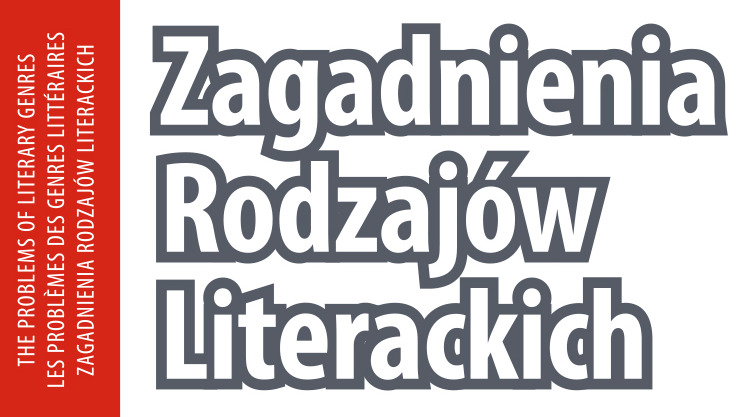Echoes of Evil: Haunted Houses and Lingering Terrors in "The Amityville Horror" and "The Conjuring"
DOI:
https://doi.org/10.26485/ZRL/2025/68.1/6Słowa kluczowe:
horror genre; Yuri Lotman; the haunted house; centre-periphery dichotomy; possessionAbstrakt
Bruce F. Kawin defines horror by its recurring motifs and its primary goal: to frighten and unsettle the audience (4). Beyond its entertainment value, horror functions within a dynamic semiotic space, where spatial structures encode tensions between order and chaos. Within Lotman’s semiosphere, the haunted house serves as a centre-periphery battlefield, where the supernatural disrupts domestic stability, shifting the house from a structured centre into a peripheral, liminal space. This article examines the haunted residence trope in Andrew Douglas’ The Amityville Horror and James Wan’s The Conjuring, analysing how spatial boundaries define the interplay between demonic forces and human attempts to reclaim domestic space. Both films, despite distinct narratives, construct the haunted house as a contested space, where supernatural peripheries threaten to consume the centre. In The Amityville Horror, the house undergoes total peripheralization, rendering it uninhabitable and reinforcing the idea of an irredeemable periphery. In contrast, The Conjuring presents a liminal haunting, where the periphery can be exorcised, restoring the house’s central function. The periphery — comprising of basements, attics, gardens, and liminal spaces — functions as an intermediary zone, where supernatural incursions blur the boundary between the mundane and the horrific. By mapping the spatial dynamics of horror, this article explores how haunted houses embody cultural anxieties about the fragility of domestic order, demonstrating how the centre-periphery dichotomy structures horror’s evolving semiosphere.
Liczba pobrań
Bibliografia
Aguirre Manuel (2008), Geometries of Terror: Numinous Spaces in Gothic, Horror and Science Fiction, “Gothic Studies” vol. 10, no. 2.
[The] Amityville Horror (2005), dir. Andrew Douglas, Metro-Goldwyn Mayer and Dimension Movies, USA [DVD].
Andrews Edna (2003), Conversations with Lotman: Cultural Semiotics in Language, Literature, and Cognition, University of Toronto Press, Toronto.
Bailey Dale (1999), American Nightmares: The Haunted House Formula in American Popular Fiction, The University of Wisconsin Press, Wisconsin.
Brittle Gerald (2002), The Demonologist: The Extraordinary Career of Ed and Lorraine Warren, iUniverse Inc., Lincoln.
Chase Robert David, Ed Warren, Lorraine Warren (2014), Ghost Hunters: True Stories From the World’s Most Famous Demonologists, Graymalkin Media. GoogleBooks edition.
[The] Conjuring (2013), dir. James Wan, Warner Bros. Pictures and New Line Cinema, USA [DVD].
Curtis Barry (2008), Dark Places: The Haunted House in Film, Reaktion Books, London.
Grider Sylvia Ann (2007), Haunted Houses [in:] Haunting Experiences: Ghosts in Contemporary Folklore, ed. D. Goldstein et al. Utah State University Press, Utah.
Hogle Jerrold E. (2002), Introduction: the gothic in western culture [in:] The Cambridge Companion to Gothic Fiction, ed. J.E. Hogle, Cambridge University Press, Cambridge.
Kawin Bruce F. (2012), Horror and the Horror Movie, Anthem Press, London.
Kaye Heidi (2015), Gothic Movie [in:] A New Companion to The Gothic, ed. D. Punter, John Wiley & Sons, West Sussex.
Kubicka Halina (2010), Tam, gdzie czai się zło. Przestrzeń w horrorze jako mechanizm budzenia strachu, “Literatura i Kultura Popularna” no. 16.
Liardon Roberts (1998), Haunted Houses, Ghosts & Demons. What You Can Do About Them, Albury Publishing, Oklahoma.
Lotman Yuri (1990), Universe of the Mind: A Semiotic Theory of Culture, trans. A. Shukman, I.B. Tauris, London/New York.
Lotman Yuri (2005), On the Semiosphere, trans. W. Clark, “Sign Systems Studies” vol. 33, no. 1.
Markovitz Fran (2004), Leaving Babylon to Come Home to Israel: Closing the Circle of a Black Diaspora [in:] Homecomings: Unsettling Paths of Return, eds. F. Markowitz, A.H. Stefansson, Lexington Books, Lanham.
McAndrew Francis (2020), The Psychology, Geography, and Architecture of Horror: How Places Creep Us Out, “Evolutionary Studies in Imaginative Culture” vol. 4, no. 2.
Meehan Paul (2011), Horror Noir: Where Cinema’s Dark Sisters Meet, McFarland, North Carolina.
Nöth Winfried (2015), The Topography of Yuri Lotman’s Semiosphere, “International Journal of Cultural Studies” vol. 18, no. 1.
Odell Colin, Le Blanc Michelle (2007), Horror Films, Kamera Books, Harpenden.
Pascuzzi Francesco, Waters Sandra (2019), Introduction [in:] The Spaces and Places of Horror, eds. F. Pascuzzi, S. Waters, Vernon Press, Wilmington.
Punter David, Byron Glennis (2004), The Gothic, Blackwell Publishing Ltd., Oxford.
Raškauskienė Audronė (2009), Gothic Fiction: The Beginnings, Vytauto Didžiojo universitetas, Kaunas.
Rata Irina (2014), An Overview of Gothic Fiction, “Translation Studies: Retrospective and Prospective Views” vol. 17.
Reyes Xavier Aldana, (2014), Gothic Horror Film, 1960–Present [in:] The Gothic World, ed. G. Byron, D. Townshend, Routledge, London–New York.
Smith Andrew (2007), Gothic Fiction, Edinburgh University Press, Edinburgh.
Spooner Catherine (2006), Contemporary Gothic, Reaktion Books Ltd., London.
Wolfreys Julian, Robbins Ruth, Womack Kenneth (2006), Key Concepts in Literary Theory, 2nd ed., Edinburgh University Press, Edinburgh.
Pobrania
Opublikowane
Jak cytować
Numer
Dział
Licencja
Prawa autorskie (c) 2025 Łódzkie Towarzystwo Naukowe i autorzy

Utwór dostępny jest na licencji Creative Commons Uznanie autorstwa 4.0 Międzynarodowe.







